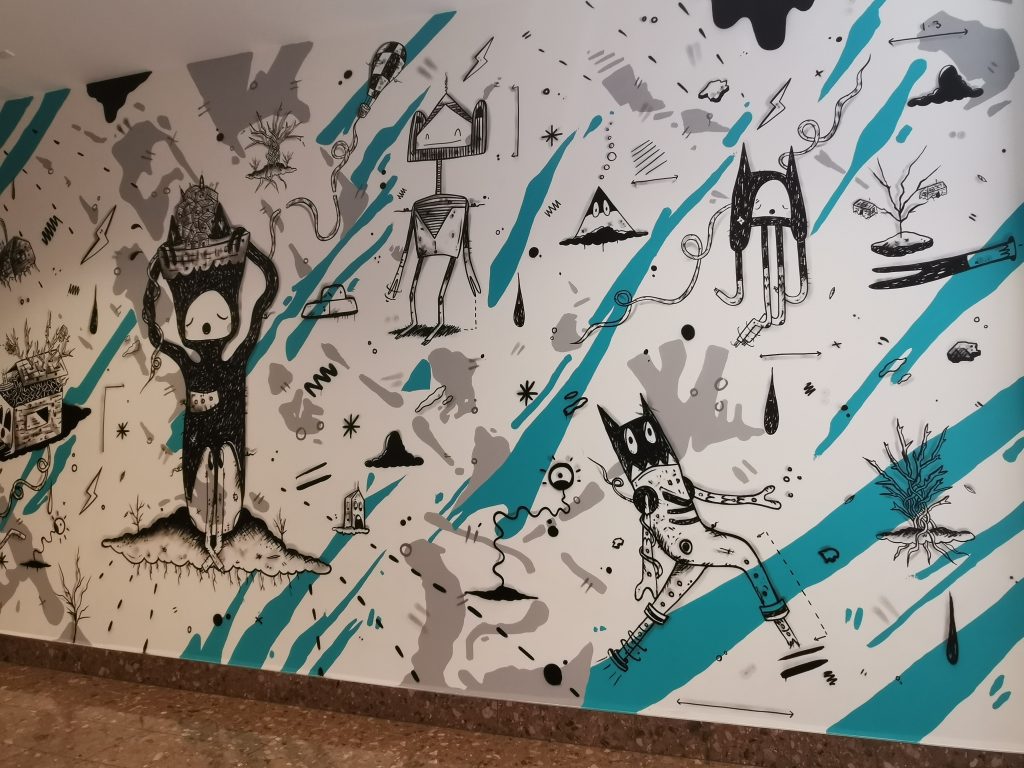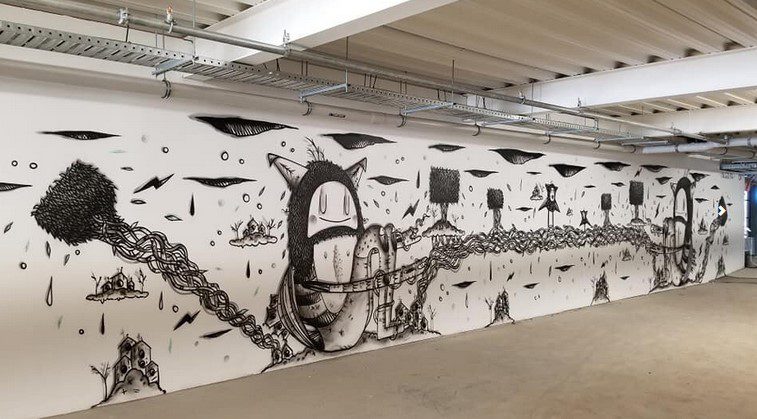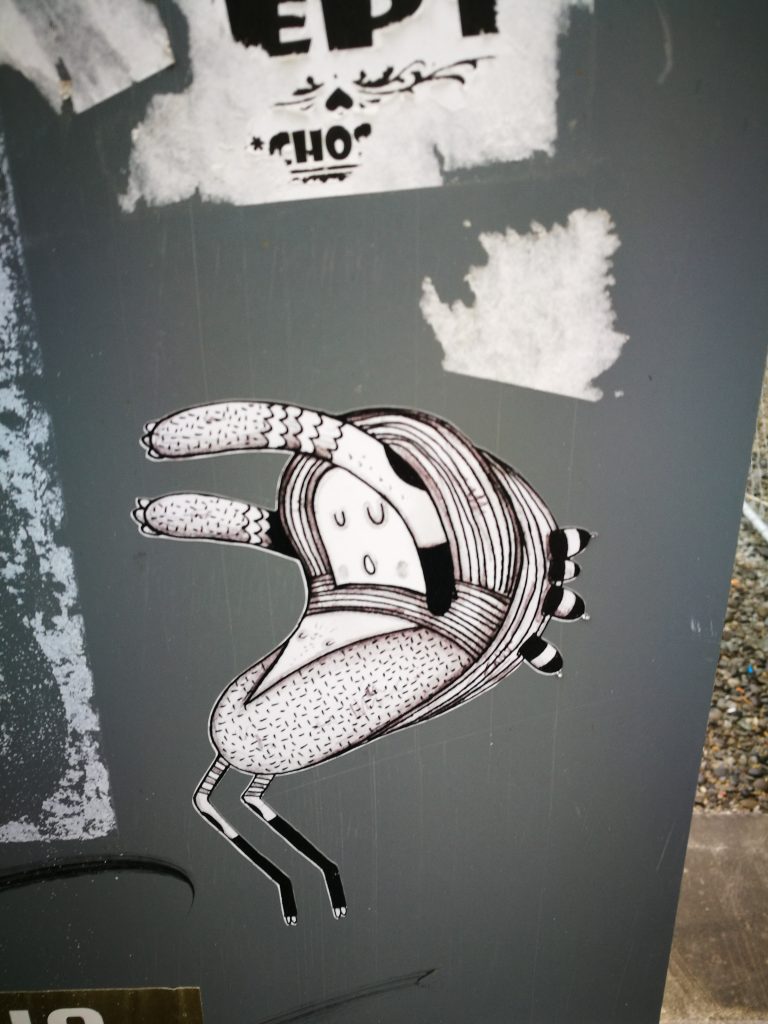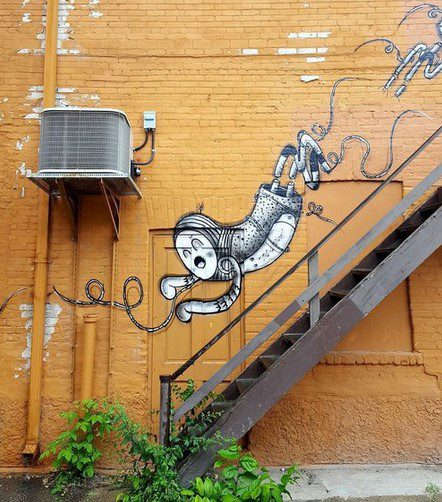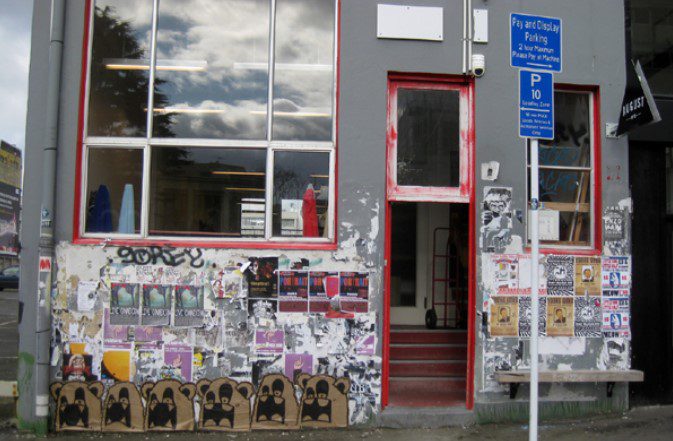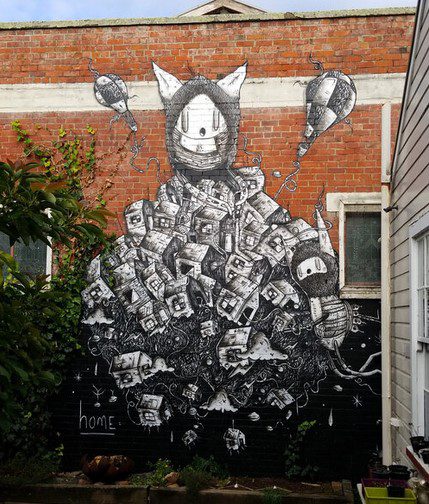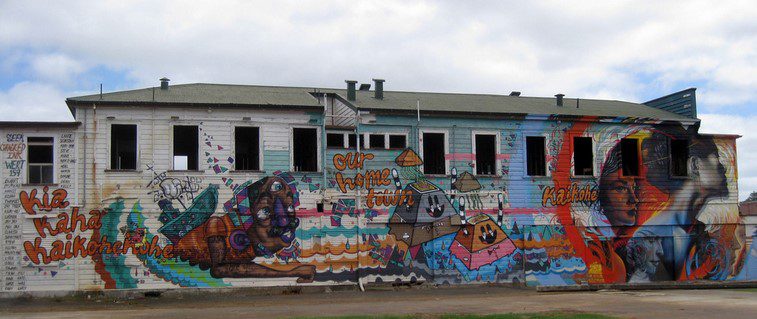We pick up with the second part of our interview with Cracked Ink immediately where we left off, discussing the artist’s entrance into the festival scene and how it necessitated a different approach to his work. For Cracked Ink, his character-based creations have unlimited narrative potential, dancing their way across walls, their interactions place them as story tellers. Jump back into our conversation with Cracked Ink as he reflects on the importance of knowing your worth, the role of social media, and the balancing act of an artistic career…
____________________________________________
As you started doing events and festivals like Sea Walls, did it make you think more about the process of creating murals? A lot of artists coming up now, they are almost immediately thinking of large-scale muralism, but that hasn’t always been the case, that transition for writers and for character-based artists or artists who were working in that post-graffiti style, muralism wasn’t necessarily the end goal…
It certainly became more narrative driven, which was actually really good for me, it made me look at my own work. The Sea Walls stuff, it’s all about ocean conservation, which allowed me to start to drill into different narratives. Is it just a visual that people want to see, or a story? It really made me look at my stuff and ask how can I push it in different directions and use different narratives? It was a kick in the ass for me a little bit, it got me thinking again. I started off with good intentions of trying to do something with content, but sometimes you drift off into this little abyss and you forget what it was all about. So that really helped me to re-centre and rethink my own game and what I was doing. From my perspective, these days new people are coming into it from different worlds, which is totally cool and amazing, there are talented artists coming into this world of muralism and stuff, but they didn’t necessarily get the opportunity to grow up the way I got into it, which is going out and painting. I don’t think it is right, I don’t think it’s wrong…
It’s just different.
I think it’s just the way life is. The trajectory of these things, the whole thing has changed.
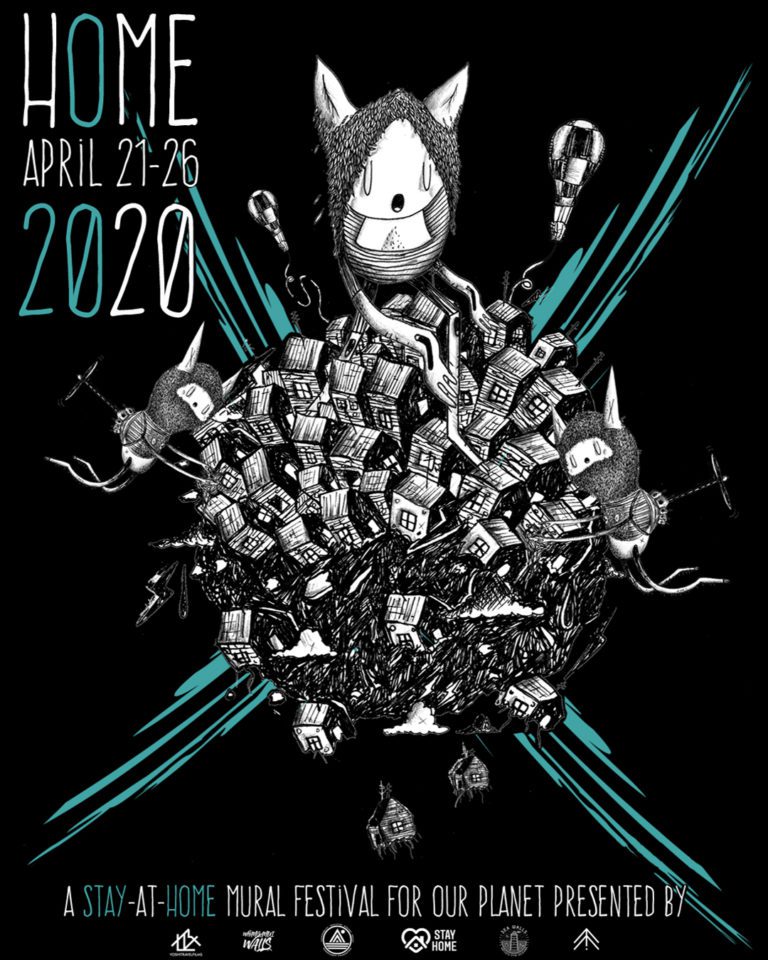
It will be interesting to look back and see the direction of muralism under these new influences. Askew made a similar point recently about how the motivations for graffiti are completely different now that young people have more platforms to express themselves. It used to be that you felt invisible and graffiti was a way to be seen, now you can post selfies 400 times a day on Instagram. That doesn’t mean graffiti becomes futile or pointless, it just means that the motivations have changed.
It’s interesting the whole dynamic with social media. As it has picked up speed over the past five years, it has changed so much. When I first signed up for all this social media stuff it was exciting, because it was about getting your work out there. But it quickly became a bit of a drain, just that whole thing of checking my phone and going through it all. I mean it is an amazing tool to share your work and for people to follow it and catch up on what you’re doing, but that need for likes and follows can make it tough to navigate…
I sometimes think it has the potential to take people away from the primary act of making and doing. You get the feeling for some people, understanding and manipulating algorithms of social media becomes the drive, rather than celebrating the work, it feels less organic. That original power of allowing people to put things in the world, empowering people, it feels like it is now overshadowed by the commercial potential of it all…
I feel sorry for the guys and girls growing up on these platforms. I feel like the purpose of why you do your art, it should always be for yourself. It should never be for someone else, the purpose of being creative and doing art is for you. It’s that outlet of yourself. When you start trying to please other people, it changes. You should be doing it for yourself, and from that people are going to like it, people are going to dislike it, but that shouldn’t change what you do. That’s a big thing that I have stuck to, I always do it for my own reasons. If other people like it, then happy days. If they don’t, that’s not my problem. I’ve always had that attitude. Once you put it onto that platform, whether people are hating it or people are loving it, you have no control over that, it shouldn’t be a focus. Creativity has never been about that.
Once you start fishing for things it becomes problematic because you start listening to an audience rather than building an audience. That’s another issue with the likes of Instagram, we are exposed to styles and trends and we start thinking about how to jump on them. In the past, it was more localised, the engagement was more real and immediate, it didn’t seem so curated. But it also meant that you were influenced by what worked in your surrounding environment. Speaking of local environments, you established the Whanganui Walls event in your hometown a few years ago, what was the inspiration to start your own festival?
Being part of the scene for 20 years and being part of so many festivals, I found it had a really interesting dynamic. When I first started, the chance of painting a big wall was kind of the ultimate goal, and with festivals you would get to paint what you want, generally. Over the years, seeing and being a part of these events, the major thing that I noticed was the amount of stuff that a city was getting and the artists were willing to go and do it for free. It is tricky because when we initially started painting, we’d go and paint stuff in the street, because that’s your zone, that’s your place, you want to be there. But there is a difference between painting a festival and painting in the street. The festival is a curated thing. Ultimately, the festival gets funding to pay for the paint, to pay for the machines, to house the artists, feed the artists, all that kind of stuff. After doing so many different festivals, it really interested me that the festivals never thought of actually compensating the artist. Some of these festival walls are absolute bangers, and the time and the effort the artist takes out of their schedule to come and paint these walls, for me, it seems unfair to the artist. Even though the artist wants to paint that wall, don’t get me wrong, they also have to pay their bills…

It’s not the super-strict commissioning relationship that you might get in another project, but it is still being used and leveraged as cultural capital…
Yeah, you see cities claiming: This is what we did! Well, I’m pretty sure there were other people that were part of it as well!
There are real benefits in having something painted on your wall. A lot of cities use murals for their tourism profile. So, why shouldn’t artists be compensated for doing that work? What other industry would you see that?
It’s such an old view, but it still exists and it’s a strange one. It’s one that I’ve been fighting for so long. I have painted a lot of festivals for nothing. That is the big misconception of going and painting a big wall, I end up going there for a week of my own time, I get materials, I get my accommodation and I get food, the basic things in life that you probably should get, you know? So, what more do you want? Well, that’s kind of old school from my perspective. Starting a festival with my partner Shanti, we wanted to bring something interesting and different to Whanganui because the city has never seen anything of this nature. It’s a small place. Compared to Christchurch, it’s just chalk and cheese. So, it was about bringing something different. But for me as an artist, it was mainly trying to create a festival that could substantiate paying the artist something. The artists get part of Whanganui Walls. We want to make it worthwhile for the artists to come to Whanganui, to take that time out of their schedule, to share their creativity with us. Like we said before, the benefits to a place are just so big. So, I feel like we have definitely helped to breakdown some barriers, and there are other guys doing it as well, like Deow down south with South Sea Spray. It’s important to go into bat for the cause, because there is a lot of old school thinking and often it comes from funding process. But ultimately as a festival organiser, its on you.
It is a big undertaking to fund a festival…
These events require substantial investment. We get support from Harrison Hire Master, who really come to the table for us, and Resene, who are the kind of company that have the backing to go OK, we’re going to give you X, Y and Z for free, which is great, but we’re not asking for stuff for free, we are saying, if you are going to give us a discount, then that’s how much money we need to obtain through funding. The whole principle of Whanganui Walls was always for everyone right through the system to get something for their efforts, whether you are part of the operations crew or you’re volunteering, you’re getting something. That was always the principle of the festival. Because these people are putting so much effort into it, and not just the artists, why are you doing it for free? The time it takes to put on one of these festivals is massive.
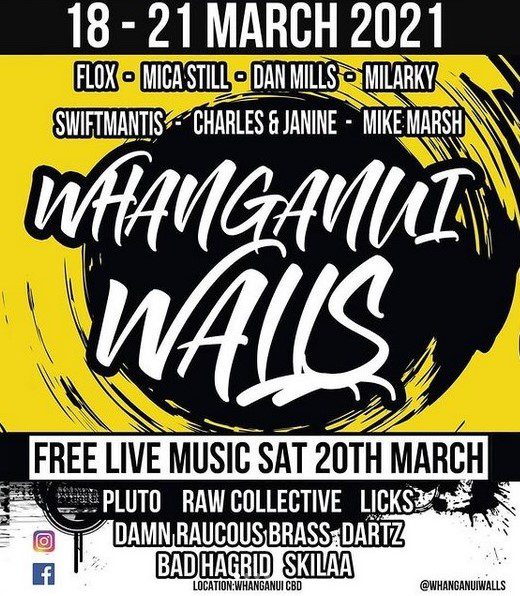
It’s not something that you fit in on a lunch break or after work. For an artist, its traveling for a week, working the whole time. You may be getting your accommodation and food paid for, but everything else still goes on back at home as well, so they need to compensate for that. It is also important to remember the years spent refining their work to get to this stage…
I’ve always been a big advocate of knowing my own worth as an artist. Sometimes, you have to walk away from things to make things right. I get it. Any artist, no matter how well you’re doing, there are always points in your career where you have your highs and you have your lows, but you have to be careful about how you devalue yourself. It is tough if you just continually bounce up and down. If you want to get some stability in your career as an artist, in my opinion, you have to stick to your guns.
We have so many super talented artists in Aotearoa, is there a real need for more mentorship to build up younger artists’ sense of self value? In New Zealand, we have a tendency to think ourselves down, is this festival a way for you to serve as a sort of a mentor figure?
It’s good to spend time with artists and ask where they are at, because there is always that tendency of not wanting to talk about this whole aspect of being an artist. Let’s take pricing a mural. There is always this tendency to just shut down about it, whether that’s because people are not confident of putting a value on what they do, so that they can survive. I’m super open with the way I do stuff. So, if an artist wants to have a conversation with me about what I do in terms of pricing or whatever it is, then I’m super open to it. I feel like without those conversations, we both don’t learn about it. One size doesn’t fit all, and if you’re at the start of your career in the art world, and in particular in muralism, there’s always things that you feel like you can’t account for, or you can’t price into a job. But even if you’re relatively new to it and you are competent and have the skills and stuff, well, why are you devaluing yourself? You’re going to produce something just as good as the next artist who may be charging double that price. I remember when I started first getting some bigger jobs, it’s nerve-wracking man, it’s nerve-wracking pricing a job because you feel like by asking for this much money and you don’t get it, then you’ve lost that job completely. But even now, if I get some decent jobs there are always tools within that process that you can use to give options to clients which ultimately will not scare them off.
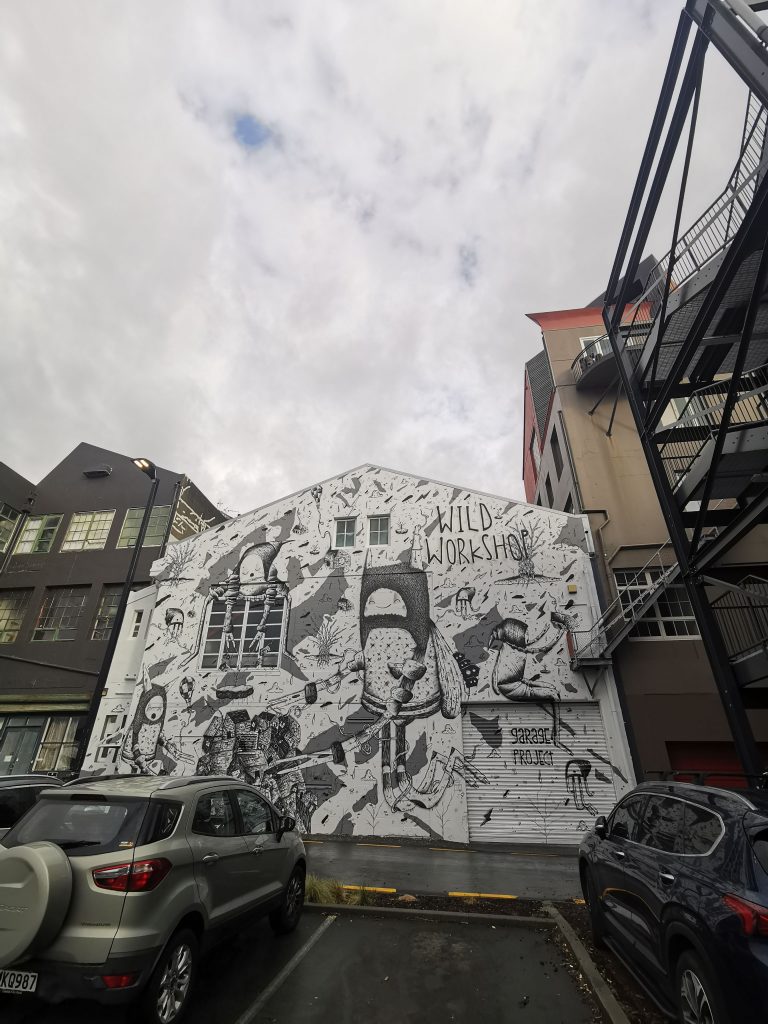
Other industries take a really hard-nosed approach to pricing, charging travel costs, time, materials… But for a lot of artists, there is the feeling that you can’t charge for things like petrol costs, or you need to take this out so that clients are more likely to agree. As much as we don’t want to emulate aspects of the commercial world, it is actually beneficial to adopt some parts…
What are your expectations if you were being commissioned to paint a wall? When you go to do that job are you wanting to pay your own travel costs? Are you wanting to pay for the machinery or for your accommodation while you are doing that job? You’re not trying to dupe anyone by doing this, but you have to try and align yourself with the expectations of a client. If they’re not paying for it, you are, so it’s really just trying to get that happy medium. From my experience doing quite a lot of large-scale commission work, you just have to be fully honest, be honest with yourself and be honest with the client, and then the conversation starts. They can always say, actually, we can’t do that, but if you don’t ask, you don’t get…
As you noted, you need to set the bar for yourself…
This has come up quite a lot recently. Being realistic about how you put your pricing in means you might not always get the dream. It’s about trying to be fair to yourself and to the client. You want to get the job, but you have to be really fair to everyone, and managing your own expectations is the hardest bit. There’s always self-doubt, there’s always that feeling that I would love this job, or I need this job, so that’s when we tend to low-ball ourselves, and before you know it, the client snaps your hand off. So, just go for it.
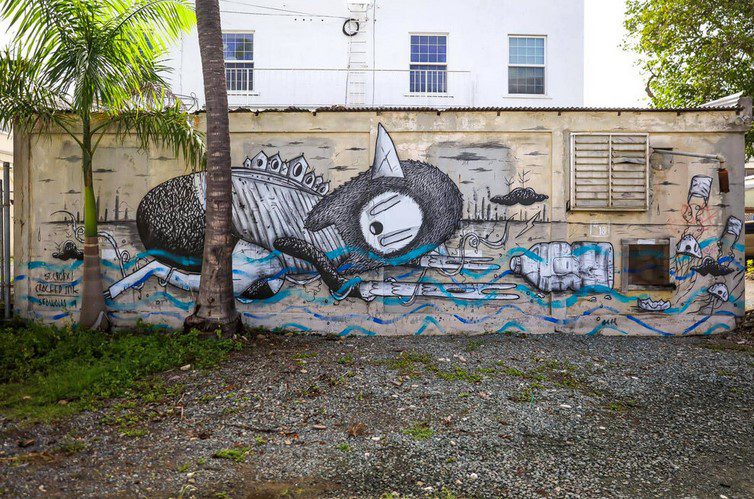
As an artist, you’re not beholden to only one way of working, you can always balance out projects to satisfy both your practical and creative needs…
It’s a malleable situation. Depending on how you want to operate, nothing is right, nothing is wrong. The main thing is if it is right for you. I have a certain style that I paint and I’m super strong on that in terms of commission work. But if you have a multitude of styles within your work and you can adapt to different commissions and you’re happy to do so, then it’s right for you. It’s just finding within yourself what is right for you, and if someone else feels that it’s wrong, that’s irrelevant. If it’s right to you, you do it. If it’s not right to you, don’t do it. You’ve got to find those boundaries. I feel like I’ve found my boundaries. I’m super black and white in terms of my artwork and in terms of the way I process things. If it’s not what I do, I don’t do it. it’s simple as that. But that doesn’t mean that’s right for someone else. It’s about finding the levels that you’re happy with and that might also ultimately mean that I don’t get as much work, but if I’m good with that, and I can get enough work to balance the books and enable myself to continue being creative constantly, that’s the goal.
That’s the key. As an artist, you have to know yourself, right?
If you can get used to the highs and the lows and make it a part of your life as opposed to making a lot of stress for yourself, which is a hard dynamic to get used to, even now it still throws you, then you can ride it. But the one thing I would say is you cannot just hold in on that and just continue because as a creative, you’re doing it because this creativity has to come out somewhere. Things evolve. Things go backwards. It’s a back-and-forth situation, but I wouldn’t change it for anything. It’s an awesome lifestyle. Opportunities come, opportunities go, and when you really take time to think about what you’re up to and where you’ve been and where you’re going you get to see what you’ve built, and you see that you’re ready to keep on building. As a creative, if you are not questioning and challenging perspectives, you shouldn’t be doing it, and if you are, it will open up a lot of possibilities.
Follow Cracked Ink online through Instagram, Facebook and his website…


